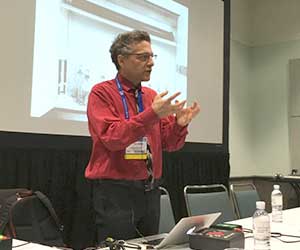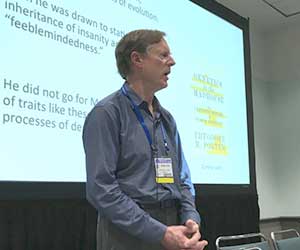March Session Reports: Pais Prize Section: Peter Galison

Peter Galison, of Harvard University, 2018 Pais Prize Awardee
Peter Galison, the 2018 winner of the Pais Prize, devoted the first part of his talk, “Filming and Writing Physics,” to recapitulating the trajectory of his career. He described how his work engaged the back-and-forth between high abstraction and concrete circumstance, exploring specific developments of instruments, experiments, images, and calculations. He outlined how he did so not only through writing, but also through filming — and he showed several examples during the course of his talk. His aim, as he described it, was to attempt to capture “how physics sits in the world”.

David Gross, University of California, Santa Barbara
Galison was followed by David Gross of the University of California, Santa Barbara, co-winner of the 2004 Nobel Prize in physics. Gross devoted his talk to “Einstein’s Quest for a Unified Theory” which, he said, had inspired Gross’s own desire to become a theoretical physicist. “Physicists are an ambitious lot,” Gross said, “but Einstein was the most ambitious of all.” Gross paid most of his attention to Einstein’s fascination with Kaluza-Klein theory to carry out these ambitions. Einstein went wrong, Gross said, by ignoring developments in nuclear and particle physics. “But his intuition that gravity must be unified with other forces of nature has to be right,” Gross concluded. “It is a task to be pursued with care and courage.”

Cathryn Carson, University of California, Berkeley
Cathryn Carson, University of California, Berkeley spoke of Galison’s students as “spokes radiating out from Peter.” She described herself as one who, like him, sits at the intersection of physics and history, though she is also involved with data sciences as well as history. She thoughtfully described the boundary issues that arise between such disciplines, and in particular the “peace treaty” that the German philosopher Wilhelm Windelband had proposed in which the natural sciences — whose model was physics — devote themselves to nomothetic explanations, or ones providing a generalized understanding, while social sciences provide idiographic descriptions of unique cases. It was an intellectual division of labor, she said, that came with an intellectual price, for it polarized the disciplines against each other, and she provided some examples.

Theodore M. Porter, UCLA
Ted Porter, of the UCLA Department of History at UCL, spoke about “(Physics) Statistics and the Ideals of Human Reason.” His talk considered episodes from the history of physics involving statistical tools and methods — the benefits and dangers. Statistics, Porter said, was “state-istics” from the beginning, “an engaged, often bureaucratic form of social science.” Data indeed drives science, Porter said. “But people (with their data and their instruments) drive science.” Understanding science as a human pursuit, he concluded, is a better way to include the public into science than to stress its law-like behavior.

Jon Else, University of California, Berkeley
Filmmaker Jon Else spoke about “Science Films in America.” He described his field as the megaphone for the work of scholars like Galison and other historians of science. In many respects it’s a deal with the devil, Else said. One has to search for vehicles in which to deliver the “precious cargo” of historians of science to citizens, but one can obscure the science and the history if one is not careful. “I don’t make the rules by which I have to play in primetime television,” he said, “but it’s fun trying to navigate those rules.” Science films are seldom purely about science, with “Powers of 10” one of the few. Most are films about technology. A few are films about the politics and policy of science, a famous example being “An Inconvenient Truth.” At the bottom in terms of viewership are films about the process of science, with “Particle Fever” being an example. He concluded by stressing the need for historians to help keep the “feet to the fire” of the filmmakers.
The articles in this issue represent the views of their authors and are not necessarily those of the Forum or APS.
